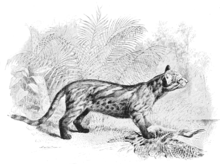Pantanal cat
| Pantanal cat | |
|---|---|
| Scientific classification | |
| Domain: | Eukaryota |
| Kingdom: | Animalia |
| Phylum: | Chordata |
| Class: | Mammalia |
| Order: | Carnivora |
| Suborder: | Feliformia |
| Family: | Felidae |
| Subfamily: | Felinae |
| Genus: | Leopardus |
| Species: | |
| Subspecies: | L. c. braccatus
|
| Trinomial name | |
| Leopardus colocola braccatus Cope, 1889
| |
| Synonyms | |
|
Leopardus braccatus | |

The Pantanal cat (Leopardus colocola braccatus) is a Pampas cat subspecies, a small wild cat native to South America.[1] It is named after the Pantanal wetlands in central South America, where it inhabits mainly grassland, shrubland, savannas and deciduous forests.[2]
Characteristics
[edit]The Pantanal cat is brown agouti on the back with a little darker spinal crest. In the face it has two transverse dark lines across each cheek. Its ears are reddish on their base, creamy-white on the outer side and bordered with a black band. Its throat is whitish and blending into orangish towards the sides and on the belly. It has some dark brown rosettes on the flanks and stripes on the legs between elbow and wrist. The tip of the tail and paws are black.[2] It is about the size of a domestic cat.[3]
There is a single report of a wild melanistic individual from Brazil, although this coat pattern has also been observed in some captive specimens.[4]
Distribution and habitat
[edit]Pantanal cats are found from sea level to 2,000 metres (6,600 ft) in east-central Brazil, Uruguay, and neighbouring regions of central South America (Bolivia, Paraguay and Argentina).[4][5] Within this region, they inhabit a range of habitats from open grassland to dense forest, although they are specifically named for the Pantanal wetlands of Brazil, Bolivia and Paraguay.[4] It has also been reported from agricultural land, and therefore must have some limited tolerance for human disturbance.[6]
Ecology and behaviour
[edit]The Pantanal cat is diurnal and solitary. It feeds on small mammals such as cavies, ground-dwelling birds, small lizards, and snakes. Home ranges are between 3 and 37 km2 (1.2 and 14.3 sq mi).[4]
Hybrids between the Pantanal cat and oncilla are known from Brazil.[7]
Taxonomic history
[edit]In 1994, it was suggested that its distinct pelage colour, pattern and cranial measurements warrant a specific status.[2] But results of phylogeographic analysis did not support this.[7][8] The validity of the genetic work has been questioned.[4]
Others regarded it as "likely [a] distinct species".[9] In 2017, it was considered a subspecies of the Pampas cat by IUCN assessors.[10]
In 2020, it was further recognized as a full species based on morphological, molecular, geographical, and ecological differences.[11][12] One further population (L. munoai) traditionally recognized as a subspecies of the Pantanal cat when it is deemed distinct, has also been elevated to full species status.[11][13]
References
[edit]- ^ Cat Specialist Group (2017). "Revised taxonomy of the Felidae. Ocelot lineage". Cat News (Special Issue 11): 76.
- ^ a b c Garcia-Perea, R. (1994). "The pampas cat group (Genus Lynchailurus Severertzov 1858) (Carnivora: Felidae), a systematic and biogeographic review" (PDF). American Museum Novitates (3096): 1–35.
- ^ Sunquist, M. E., Sunquist, F. C. (2002). "Pampas cat Oncifelis colocolo (Molina, 1782)". Wild Cats of the World. Chicago: University of Chicago Press. pp. 200–204. ISBN 978-0-226-77999-7.
{{cite book}}: CS1 maint: multiple names: authors list (link) - ^ a b c d e Barstow, A.L.; Leslie, D.M. (2012). "Leopardus braccatus (Carnivora: Felidae)" (PDF). Mammalian Species. 44 (1): 16–25. doi:10.1644/891.1.
- ^ Díaz Luque, J. A., Beraud, V., Torres, P. J., Kacoliris, F. P., Daniele, G., Wallace, R. B., and Berkunsky, I. (2012). First record of pantanal cat, Leopardus colocolo braccatus, in Bolivia. Mastozoología neotropical 19(2): 299–301.
- ^ Araujo Bagno, M. (2004). "Notes on the natural history and conservation status of pampas cat, Oncifelis colocolo, in the Brazilian Cerrado". Mammalia. 68 (1): 75–79. doi:10.1515/mamm.2004.011. S2CID 84749514.
- ^ a b Johnson, W.E.; et al. (1999). "Disparate phylogeographic patterns of molecular genetic variation in four closely related South American small cat species". Molecular Ecology. 8 (S1): S79–S94. doi:10.1046/j.1365-294X.1999.00796.x. PMID 10703553. S2CID 34990824.
- ^ Wozencraft, W. C. (2005). "Order Carnivora". In Wilson, D. E.; Reeder, D. M. (eds.). Mammal Species of the World: A Taxonomic and Geographic Reference (3rd ed.). Johns Hopkins University Press. pp. 537–538. ISBN 978-0-8018-8221-0. OCLC 62265494.
- ^ Sunquist, M. E. & Sunquist, F. C. (2009). "Colocolo (Leopardus colocolo)". In Wilson, D. E.; Mittermeier, R. A. (eds.). Handbook of the Mammals of the World Vol. 1. Barcelona: Lynx Edicions. p. 146. ISBN 978-84-96553-49-1.
{{cite book}}: CS1 maint: multiple names: authors list (link) - ^ Lucherini, M.; Eizirik, E.; de Oliveira, T.; Pereira, J.; Williams, R.S.R. (2016). "Leopardus colocolo". IUCN Red List of Threatened Species. 2016: e.T15309A97204446. doi:10.2305/IUCN.UK.2016-1.RLTS.T15309A97204446.en.
- ^ a b Nascimento, F.O.D.; Cheng, J.; Feijó, A. (2021). "Taxonomic revision of the pampas cat Leopardus colocola complex (Carnivora: Felidae): an integrative approach". Zoological Journal of the Linnean Society: 575–611. doi:10.1093/zoolinnean/zlaa043.
- ^ "Leopardus braccatus". ASM Mammal Diversity Database. American Society of Mammalogists. Retrieved 8 December 2023.
- ^ "Leopardus fasciatus". ASM Mammal Diversity Database. American Society of Mammalogists. Retrieved 8 December 2023.
